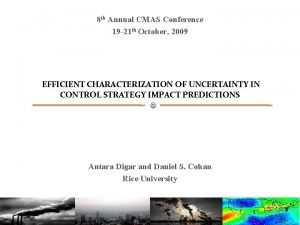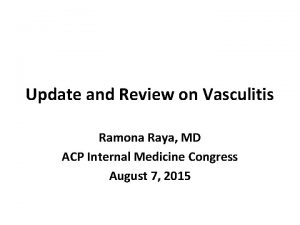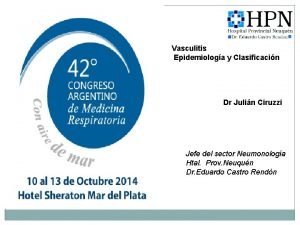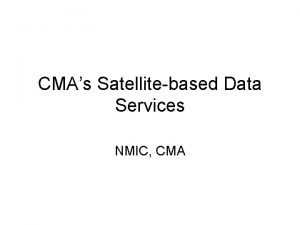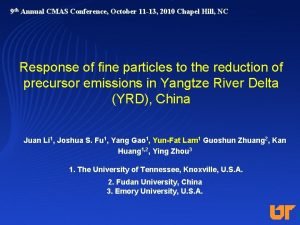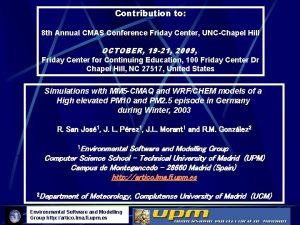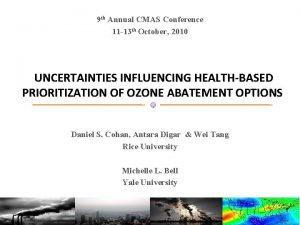the 11 th Annual CMAS Conference Chapel Hill













- Slides: 13

the 11 th Annual CMAS Conference, Chapel Hill, NC, October 15 -17, 2012 October 16, 2: 40 PM, Grumman Auditorium (Model Evaluation and Analysis) Kazuyo Yamaji Japan Agency for Marine-Earth Science and Technology, Yokohama, Japan (kazuyo@jamstec. go. jp) Hitoshi Irie (satellite) Chiba University, Chiba, Japan Jun-ichi Kurokawa (emission) Asia Center for Air Pollution Research, Niigata, Japan Toshimasa Ohara (emission) National Institute for Environmental Studies, Tsukuba, Japan ACKNOWLEDGEMENTS the global environment research fund (S-7) of the ministry of the environment the support program for young and women researchers of University of Tokyo

• East Asia, especially central eastern China(CEC), has largest emissions. CEC • Simulated NO 2 VCDs (vertical column densities) were underestimated over CEC. e. g. by RAMS/CMAQv 4. 4 +REASv 1. 0 (Uno et al. , 2007), multi-model ensemble simulations (van Noiji et al. , 2006) These problems were caused by emissions? , retrievals? , or both? BUT the reasons have been still unclear • CTM’s horizontal grid resolutions may affect on simulated NO 2 VCDs. Finer resolutions made larger NO 2 VCDs over large source regions (e. g. Wild et al. , 2006; Valin et al. , 2011). In this study, we investigated influence of horizontal grid resolutions in the model system using, WRF-CMAQv 4. 7. 1 updated REAS*, on NO 2 VCDs over East Asia *REAS: Regional emission inventory in Asia developed at Japan (Ohara et al. , 2007)

l Meteorology WRF ver. 3. 3. 1 with NCEP ds 083. 2 for the year 2007 [setup]Thompson(microphysics), ACM 2(PBL physics), RRTM(longwave), Dudhia(shortwave) l Chemistry CMAQ ver. 4. 7. 1 [setup] PPM (advection), ACM 2_inline(vertical diffusion), SAPRC 99 (gas), AERO 5 (aerosol ) l Emissions updated REAS (monthly) with 0. 25° horizontal resolution for 2007 (anthropogenic), RETRO (biomass burning), MEGANv 2 (biogenic emissions) l Boundary conditions outputs from global model (CHASER) for the outer domain outputs from the outer domains (nested) for the inner domains l Vertical resolution 37 layers, top=50 h. Pa, the first mid-layer height=20 m

terrain elevations NO 2 emissions in June 2007 Domain 1, D 1 Domain 2, D 2 Domain 3, D 3 Domain 4, D 4 horizontal resolutions grid numbers NO 2 emissions over CEC 80 km 95 × 75 40 km 110 × 88 20 km 184 × 132 292 × 182 1. 1 kmoles s-1

• GOME-2 passing over the equator at 9: 30 LT • SCIAMACHY at 10: 00 LT • OMI at 13: 45 LT *These retrievals using with the same basic algorithm (DOMINO products for OMI and TM 4 NO 2 A products for SCIAMACHY and GOME-2) (Irie et al. , 2012) in this study, CMAQ NO 2 VCDs • at 9: 00 CST (Chinese Standard Time) • at 10: 00 CST • at 14: 00 CST was used, respectively.

JUN, morning • • • JUN, afternoon DEC, morning DEC, afternoon These maps compare monthly averaged NO 2 VCDs from CMAQ(D 1) and satellites. CMAQv 4. 7. 1 with updated REAS can capture well satellite NO 2 VCDs even at D 1 CMAQ overestimates over Shanghai area In December, CMAQ underestimates over large emission areas On the other hand, CMAQ NO 2 VCDs are higher over clear area, e. g. over sea

JUN, morning JUN, afternoon DEC, morning DEC, afternoon • These maps compare monthly averaged NO 2 VCDs from CMAQ at D 2, D 3, and D 4 and satellites • CMAQ NO 2 VCDs are increased due to the horizontal resolution change • Finer resolutions can produce in detail NO 2 VCDs distribution • Meanwhile, the finer resolutions results overestimation at some grids.

using monthly averaged NO 2 VCDs in a 1 degree grid of all and diagnostic regions (A, B, C, and D) shown in this map. • Generally, correlations between CMAQ and satellites are reasonable • Finer resolutions produce larger NO 2 VCDs at most grid • In December, CMAQ tends to overestimate over the cleaner area • In the morning in December, CMAQ tends to underestimate over the large emission areas

all region resolution D 1 D 2 diagnostic regions B C A D 3 D 4 D 1 D 2 D 3 D 4 JUN 2007 GOME-2 SCIA OMI 47 63 69 78 77 121 119 130 -47 -40 -37 -32 27 60 65 70 2 12 18 38 53 102 121 136 47 65 73 80 94 80 103 121 54 60 117 99 -2 12 19 30 -4 -9 5 20 3 15 56 46 -9 1 4 38 18 18 38 76 1 20 64 66 DEC 2007 GOME-2 SCIA OMI -6 5 12 17 26 -36 -29 -23 -20 0 39 55 67 76 49 39 10 66 51 19 78 58 -32 -23 -21 -18 34 36 44 46 0 -1 24 -53 -48 -46 -43 8 10 17 18 -3 -4 87 9 21 26 32 84 90 102 107 58 57 1 2 -2 -1 63 66 *Biase(%)=(CMAQ NO 2 VCDs - satellite NO 2 VCDs) / satellite NO 2 VCDs *100, using monthly and regional averages • The horizontal resolution change, from D 1 to D 2, D 3, and D 4 was not necessarily make improvements the biases between CMAQ NO 2 VCDs and satellite retrievals • The negative biases at D 1 are decreased or changed to positive biases due to the resolution change • The positive biases are increased due to the resolution change, esp. comparing with GOME-2 in the morning in JUN and OMI in the afternoon in DEC

A region resolution D 2 D 3 B D 4 D 2 D 3 C D 4 D 2 D 3 D 4 JUN 2007 (9: 00 CST) NOx NOy NOz 1. 2 1. 3 1. 1 1. 0 1. 1 0. 9 1. 1 1. 2 1. 0 1. 1 1. 0 0. 8 1. 1 1. 2 1. 3 1. 0 1. 1 1. 0 0. 7 1. 1 1. 6 1. 5 1. 0 1. 4 1. 0 0. 9 1. 0 0. 4 JUN 2007 (13: 00 CST) NOx NOy NOz 1. 1 1. 2 1. 3 1. 1 1. 2 1. 0 1. 1 1. 2 1. 1 1. 0 1. 1 0. 9 1. 1 1. 2 1. 0 1. 1 1. 0 0. 9 1. 0 0. 7 1. 1 1. 0 1. 1 0. 9 1. 0 DEC 2007 (9: 00 CST) NOx NOy NOz 1. 1 1. 3 1. 1 1. 2 1. 0 1. 1 1. 2 1. 3 1. 0 1. 1 1. 0 0. 9 1. 0 1. 1 1. 2 1. 3 1. 1 1. 0 1. 1 1. 2 1. 0 1. 1 DEC 2007 (13: 00 CST) NOx NOy NOz • • 1. 1 1. 3 1. 1 1. 2 1. 0 1. 1 1. 2 1. 3 1. 0 1. 1 1. 0 0. 9 1. 0 1. 1 1. 3 1. 0 1. 1 1. 0 0. 9 1. 1 1. 2 1. 3 1. 1 1. 2 1. 0 1. 1 *increasing from D 1 *decreasing from D 1 NOx VCDs are increased with the resolution change from D 1 to D 2, D 3, and D 4 without linear chases in the sequence, D 1 -D 2 -D 3 -D 4 The largest increments in the change from Dn to Dn+1 appeared in the morning were 18% at A (from D 1 to D 2), 12% at B (from D 1 to D 2), and 13% at C (from D 2 to D 3) and 42% at D (from D 2 to D 3) On the other hand, NOz VCDs did not have monotonic changes These seemed to be affected by both of in-situ non-linear chemistry and transport.

l Multi-scale nested simulations (horizontal resolutions, 80, 40, 20, and 10 km) has been done to investigate influence on NO 2 VCDs l This model, even at the coarsest resolution, can capture well satellite NO 2 VCDs l NO 2 (NOx) VCDs are increased with the resolution change from D 1 to D 2, D 3, and D 4 l However, the increased NO 2 VCDs due to the resolution change did not necessarily show better agreement with the satellite retrievals in this study l The largest increment in the change from D 2 to D 3 appears in the morning in June was 42% at region D (near Tokyo) l NOz VCDs changes due to the resolution change are more complex because of in-situ non-linear chemistry and transport


D 1(80 km) D 3(40 km)
 Cmas conference
Cmas conference Dr ramona raya
Dr ramona raya Consenso de chapel hill
Consenso de chapel hill Ohre unc
Ohre unc Unc chapel hill cs
Unc chapel hill cs Unc chapel hill ib credit
Unc chapel hill ib credit Enrolled agent chapel hill, nc
Enrolled agent chapel hill, nc Connectcarolina
Connectcarolina Unc hematology oncology clinic
Unc hematology oncology clinic Hepi annual conference
Hepi annual conference Travel health insurance association annual conference
Travel health insurance association annual conference Https //bit.ly2v
Https //bit.ly2v Edgar figueroa md mph
Edgar figueroa md mph Nmls conference
Nmls conference
